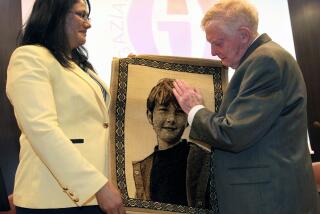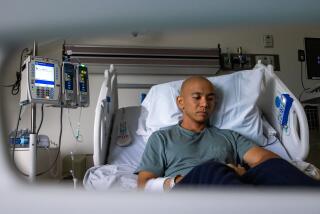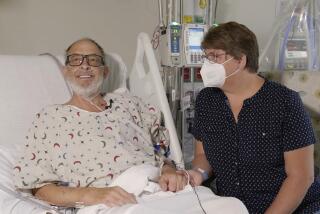Unusual Transplants Offer a Double Dose of Hope
UCLA surgeons performed a rare “domino” liver transplant Tuesday, giving a 29-year-old victim of a genetic disease half of a close friend’s liver and then implanting his organ in a woman with liver cancer.
The complex surgery, which is expected to save both patients’ lives, illustrates the desperate steps surgeons must sometimes take for patients who are not likely to receive conventional transplants. Both Jeffrey Cross and Lily Cheng had very low priorities for donor organs and were unlikely to live long enough to reach the top of a waiting list.
Cross’ tale also emphasizes the importance of obtaining a second opinion when a serious disease is diagnosed. The Westwood man was effectively given a death notice by one physician, who incorrectly diagnosed his disease. But his fiancee’s persistence in contacting other physicians eventually led to the correct diagnosis and the chance at surgery.
The fiancee, JoAnna Poblete, was also instrumental in helping to find a living donor for Tuesday’s surgery.
“She didn’t accept the first diagnosis and basically saved my life,” Cross said Monday. “The lesson is that you have to take care of your own medical scenario. No one else is going to do it for you.”
Cross, a computer technician for Creative Artists Agency, suffers from a rare genetic disorder called familial amyloidosis, which affects about one in every 4 million people in the United States.
His liver has a defective form of an enzyme necessary to break down a protein called transthyretin, or TTR. As a result, the partially decomposed TTR accumulates in the nerves, eyes and heart, where it causes severe damage.
Cross’ heart was failing as a result of the TTR buildup and his physicians recognized that death was imminent unless his liver could be replaced. But his liver worked fine otherwise, so he had a very low priority for a donor organ.
Enter Doug Andrews, 32, a youth pastor at First Baptist Church in San Mateo, Calif. Doug’s wife, Krissie, had been Jeff Cross’ best friend since kindergarten. Jeff was in Doug and Krissie’s wedding eight years ago, and the men had been good friends since.
A Resource Not to Be Wasted
When JoAnna sent an e-mail to the couple’s friends noting that Jeff needed a living donor who had O-positive blood, Doug didn’t think twice. He was tested and found to be a good candidate to donate half his liver. It was comforting, he said, “to know that I have something I can give that will save a friend’s life.”
Jeff’s liver was too good a resource to waste, however; even with the genetic defect, it functioned well. So his UCLA surgeon, Dr. Ronald Busuttil, decided to give it to Lily Cheng, 43, who has liver cancer. Cheng, a single mother with a 15-year-old son, operates an export/import business in Rancho Santa Margarita.
Lily’s oncologists would have to remove her liver to cure her cancer. But she was not a high-priority candidate for a donor liver because she had hepatitis B, which would reinfect the new liver. Cross’ liver “was a godsend for her,” Busuttil said.
Jeff’s liver would be nearly ideal for her. It takes 30 years or so for the accumulation of defective proteins in amyloidosis to severely damage organs. By that time, Lily would be 73. Who knew what treatments would be available by then?
So Tuesday morning at 5 a.m., the surgical team began operating. One group removed half of Doug’s liver. The second removed Jeff’s. They did not begin operating on Lily, however, until they were sure Jeff’s liver was acceptable for her. Ultimately, Doug’s half-liver was implanted in Jeff, Jeff’s liver was implanted in Lily, and her diseased organ was discarded.
The procedure ended about 3:30 p.m. “Everything came out beautifully,” Busuttil said.
The liver has remarkable recuperative powers. Doug’s liver will grow back to nearly full size. After a week in the hospital and three weeks or so of bed rest, he will be able to resume all his normal activities with no limitations resulting from the surgery.
Jeff’s recovery will be somewhat longer and he will have to take immune-suppressing drugs for the rest of his life. His liver will also grow to normal size. The one-year survival rate for liver transplants with a living donor is about 85%.
As for his disease, “we would expect production [of defective TTR] to be completely stopped,” said Dr. Morie A. Gertz of the Mayo Clinic in Rochester, Minn. “We can’t predict with certainty, but there have been many instances in the past [following identical procedures] in which the defective TTR was reabsorbed” and destroyed.
The surgeons found no evidence that Lily’s tumor had spread outside her liver, and her prognosis is very good too.
Jeff Cross almost didn’t make it to Tuesday’s surgery because of the initial misdiagnosis. He was adopted and did not know his biological family’s genetic history, so when he developed pain in his feet last summer, its origin was a mystery. In August, he developed a bluish spot in his left eye. Although he sought treatment, his vision continued to deteriorate.
Search for Correct Diagnosis
In April, physicians concluded that his foot and eye problems might be related. After large numbers of negative tests, a hematologist concluded that he had primary amyloidosis, the most common form of the disease. It originates in the bone marrow and affects more organs than the familial form.
The hematologist told him that he might be helped by chemotherapy and a bone marrow transplant, but that the condition was usually terminal.
Poblete, a graduate student in history at UCLA, was not content to accept this diagnosis. She compiled Jeff’s medical records and began e-mailing them to specialists in amyloidosis nationwide.
Within an hour after she sent an e-mail to Gertz, Poblete said, he was on the phone urging them to come to Minnesota for more tests. That was a Thursday. They were on the plane the next Monday.
“When I got the e-mail, I was very disturbed,” Gertz said. “The main thing was, the average age of onset for the type [of amyloidosis] he was supposed to have was 62. That didn’t prove anything, but it raised a lot of red flags.”
Gertz doesn’t fault the L.A. doctor who misdiagnosed Jeff. “It’s very difficult. There is no diagnostic blood test, no diagnostic X-ray or scan. You have to see the symptoms and do the necessary biopsies. There’s no substitute for experience. It would take an exceptional physician to diagnose something he has never seen before.”
With the proper diagnosis in hand, Gertz sent Jeff back to UCLA for the transplant.
Poblete’s conclusion: “I totally advocate for second opinions. You should seek out the best person for the condition you have and make sure you are doing everything you can to get the best treatment. Everything has come together now, and I have no doubt that things are going to go right.”






